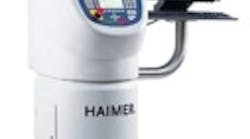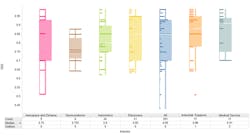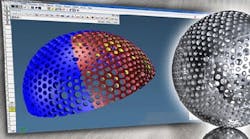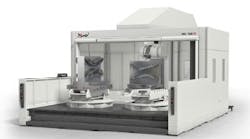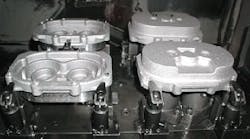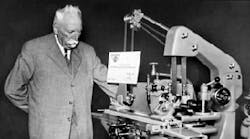"A well balanced toolholder with an unbalance of 1.0 gm-mm would produce a radial force of 0.56 lb at 15,000 rpm.
When researching toolholders and their balancing requirements, it was discovered that the average initial unbalance for CAT-50 toolholders was about 250 gm-mm. At 15,000 rpm, 250 gm-mm of unbalance produces a continuous radial force of 140 lb!" Michael Layne, a product manager for American Hoffman Corp. (www.hoffmanglobal.com) said in a white paper. Layne wrote the paper, "Detecting and Correcting Unbalance in Toolholders for HighSpeed Machining," for his company, American Hoffman Corp., a manufacturer of precision balancing machines.
Layne said an imbalance in tooling could cause chatter or ripples in the metal surface because of the movement of the cutting tool. Highfrequency chatter also can result in poor surface finish. Unbalance also can lead to an inability to hold close tolerances and to an increase in scrapped parts.
On a machine, unbalance can result in premature spindle bearing failure and costly downtime. Recent research by several major toolholder manufacturers indicates that tool life can be improved by as much as 50 percent with balanced toolholders and tools. The tool, toolholder and the retention knob (if applicable) should be balanced as an assembly. However, not all tools require balancing. Each tool in a process should be evaluated to determine if the application justifies close-tolerance balancing. Tool rpm, tool weight, tool operation and stress applied on the spindle should be considered.
Unbalance can be a result of fixed sources, including the features of a toolholder, or a result of variable sources, such as the position of the collet, or the position of the collet nut, or the cutting tool, or the setscrews that are used on end mill holders. Fixed sources of unbalance usually are addressed by the toolholder manufacturer through design and prebalancing. Variable sources of unbalance are likely to change each time the cutting tool is changed or when the collet is loosened and re-clamped. Toolholders that do not have moving parts, such as shrink-fit toolholders, tend not to lose their balanced state after they are pre-balanced. Hydraulic chucks also are easy to balance, and retain balancing in use.
Regardless of spindle speeds and the type of toolholder that is used, the cost reduction and other benefits that come from a closetolerance, in-house program to balance toolholder and tools provide quick returns.
Tool setting in 10 seconds
Rego-Fix Tool Corp. (www.rego-fix.com) has developed a simple and fast—under 10 seconds—alternative to heat-shrink and mechanical methods of toolholding.
The toolholding company designed its trademarked powerRgrip toolholding process for holding tools in high-precision, high-speed machining. powerRgrip is a mechanical clamping system that Rego-Fix says maintains stronger gripping forces than shrink-fit toolholders.
The system is elegant in its simplicity: It uses a proprietary, compact hydraulic press to accurately and securely insert a tool into a collet, and the collet into the toolholder. The benchtop hydraulic press is designed to exert the exact pressure—as much as six tons—to seat the collet and tool. The hydraulic press also reverses to disassemble the tool, collet and toolholder. Toolholding is keyless, and relies on the concentric force of the toolholder to keep the tool in place.
The system is designed to provide even higher levels of accuracy and precision than existing toolholding systems, and can use tools with clamping diameters from 0.20 mm to 20 mm (0.0787402 in. to 0.7874016 in.) in the same holder. It does not have the small tool limitations that shrink toolholding system have.
Andreas Weber, president of Rego-Fix Tool Corp., said his company recently developed holders for microdrills and micro-mills to allow powRgrip to use clamping diameters as small as 0.20 mm.
The powRgrip system ensures run-out capacity to less than 3 (0.0001181 in.), and the company says it maintains that tolerance even after 20,000 tool changes. Also, the system presets tools to less than 10 (0.0003937 in.)
"This has the highest clamping power and run-out accuracy of any toolholding systems," Weber said, adding that the system's dynamic clamping power also provides high vibration dampening in the cut.
In addition to its mechanical properties, Weber said the powRgrip system delivers preset tools cold to the touch, so there is no waiting for heat to dissipate after presetting, as there is in heat-shrink systems.
Rego-Fix is planning to showcase its powRgrip system at the Eastec trade show May 22-24 in West Springfield, Mass.
Shrink-Fit Tool Recommenadtions
The advantages of shrink-fit technology for toolholding include improved gripping power and concentricity, and the technology has become very popular with machinists.
The theoretical gripping pressure of shrink-fit technology is a function of the interference between the bore and the tool shank and the wall thickness of the holder. This is derived from equations based on the Lames Theory. The clamping pressure for carbide shanks is approximately 10 percent less than an equal size steel cutting tool due to the difference in the Poisson ratio between the two materials.
The pullout force is a function of the gripping pressure, the coefficient of friction and the contact surface area. Typical calculations use a coefficient of friction of 0.15. This assumes a surface finish of between 12 and 16 micro inches on the holder I.D., and a surface finish of 8 micro inches on the tool shank. Testing at Command Tooling Systems (www.commandtool.com) with steel on steel with a finish on both parts 16 micro inches confirms the calculated numbers. This implies that a carbide tool with a better finish would pull out with less force than calculated with a coefficient of friction of 0.15. The pull-out force is proportional to the coefficient of friction. Experience further indicates that super finished carbide shanks on highhelix cutters will pull out under heavy cuts or chatter. Thus, tool shanks should have a finish that is no finer than 16 micro inches for optimum holding power.
The following table provides tolerances for a variety of shank sizes:
| SHANK SIZE | TOLERANCE |
| 0.236 in. to 0.394 in. ( 6 mm to 10 mm) | -0.00035 in. (-0.009 mm) |
| 0.394 in. to 0.709 in. (10 mm to 18 mm) | -0.00043 in. (-0.011 mm) |
| 0.709 in. to 1.181 in. (18 mm to 30 mm) | -0.00051 in. (-0.013 mm) |
| 1.181 in. to 1.968 in. (30 mm to 50 mm) | -0.00063 in. (-0.016 mm) |
Tool shanks should be round, without flats, raised engraving, dents or other surface imperfections.
Cleaning the mating parts is essential, and a nonflammable solvent is the recommend cleaning agent. Oil will turn to sludge during the heating process and will effectively "glue" the components together. Care should be taken to avoid trapping moisture behind the cutting tool as expanding gases may create high pressures during tool removal.
For additional information, contact Dennis King at Command Tooling Systems, LLC at 800.328.2197. Command Tooling Systems, LLC 13931 Sunfish Lake Blvd NW Ramsey, MN 55303 [email protected]
